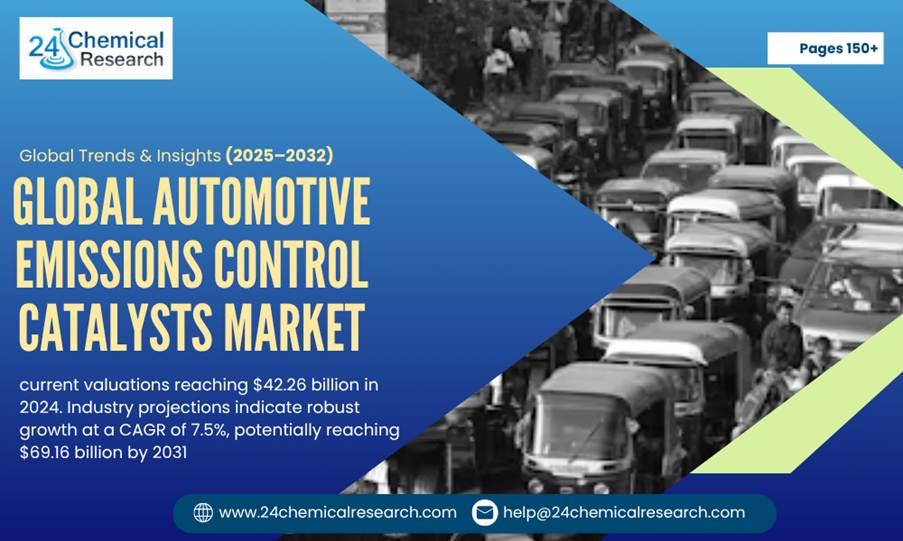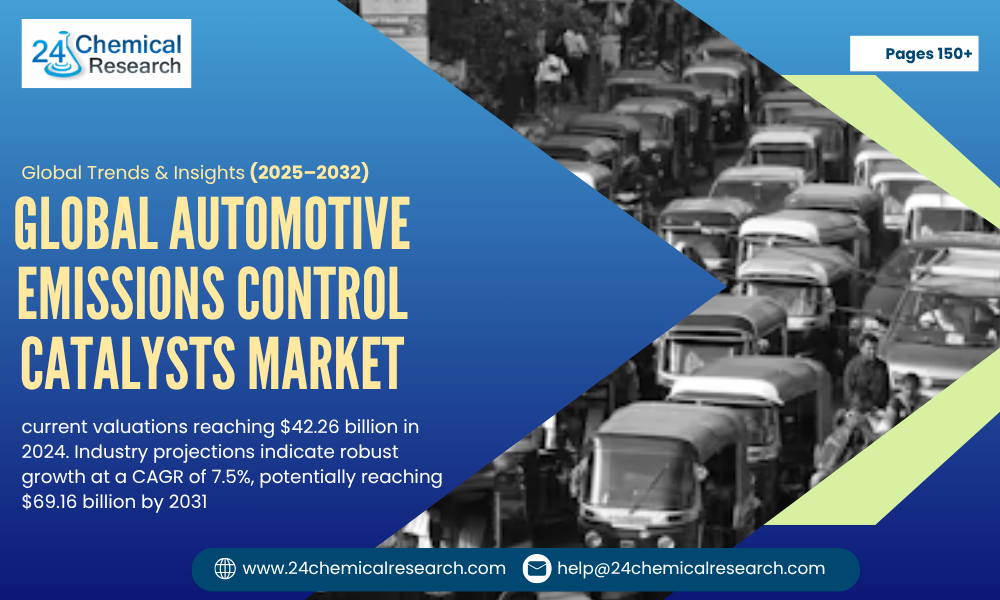Global Automotive Emissions Control Catalysts Market continues its upward trajectory, with current valuations reaching $42.26 billion in 2024. Industry projections indicate robust growth at a CAGR of 7.5%, potentially reaching $69.16 billion by 2031. This expansion is primarily fueled by stringent environmental regulations worldwide and the automotive industry's accelerating shift toward cleaner technologies.
Automotive emission control catalysts play a critical role in modern vehicle exhaust systems, transforming harmful pollutants like nitrogen oxides, carbon monoxide, and hydrocarbons into less toxic substances. Their importance has grown exponentially as governments worldwide implement increasingly strict emissions standards, particularly for gasoline, diesel, and hybrid vehicles.
Download FREE Sample Report: https://www.24chemicalresearch.com/download-sample/297097/global-automotive-emissions-control-catalysts-forecast-market-2025-2031-33
Global Market Insights and Regional Dynamics
Asia-Pacific dominates the global market, accounting for over 56% of automotive production. China leads with 32% of global vehicle manufacturing, followed by Japan – the world's largest vehicle exporter with over 3.5 million units shipped in 2022. The region's growth is further propelled by rapid urbanization and increasing middle-class populations adopting personal vehicles.
Europe maintains strong market presence through its rigorous Euro 6 and forthcoming Euro 7 standards, driving continuous innovation in catalyst technologies. North America follows closely, with the U.S. Environmental Protection Agency's Tier 3 regulations pushing for cleaner vehicles. Emerging markets in Latin America and Africa present growth opportunities, though infrastructure challenges remain
Market Segmentation Analysis:
Market Segmentation by Type
- Palladium Based Catalyst
- Rhodium Based Catalyst
- Platinum Based Catalyst
- Others
Market Segmentation by Application
- Heavy-Duty Vehicles
- Off-Road Vehicles
- Passenger Cars & Light Duty Vehicles
- Others
Market Segmentation and Key Players
- Johnson Matthey
- BASF
- Haldor Topsoe
- Umicore
- Corning
- Clariant
- Zeolyst International
- Heraeus Holding
- Solvay
- Cormetech
- NGK Insulators
- Aristo Global
- Nett Technologies
- Cataler Corporation
- Clean Diesel Technologies
Major Growth Drivers and Emerging Opportunities
The market's expansion is underpinned by several critical factors. Stricter global emissions standards top the list, followed by rising vehicle production – despite the 2022 dip to 81.6 million units from the 2017 peak of 97.3 million. The electric vehicle revolution, surprisingly, creates new opportunities as hybrid vehicles still require sophisticated emissions control systems.
Technological advancements in catalyst formulations present significant opportunities, particularly in developing more efficient and durable platinum group metal (PGM) combinations. The growing aftermarket for replacement catalysts in aging vehicle fleets represents another lucrative segment, especially in developed markets with extended vehicle lifespans
Future Outlook and Strategic Recommendations
The global automotive emissions control catalysts market is on the brink of significant evolution as regulatory frameworks become increasingly stringent and the automotive industry transitions toward cleaner powertrain technologies. With Euro 7 and China 7 emission standards expected to set new benchmarks in vehicle emissions, manufacturers are under mounting pressure to innovate. The future of this market will depend largely on the industry’s ability to deliver catalysts that are not only highly efficient but also cost-effective, especially given the volatility of platinum group metal (PGM) prices.
A central pillar for future growth lies in investment in research and development (R&D). Developing next-generation catalysts with improved durability, thermal stability, and reduced dependence on costly PGMs will be crucial. Such advancements will enable compliance with ultra-low emission requirements while maintaining competitive pricing. In parallel, diversification of supply chains is emerging as a strategic imperative. With palladium and rhodium supply frequently disrupted by geopolitical and mining constraints, companies must explore alternative sourcing and recycling initiatives to secure stable raw material availability.
The rise of hybrid vehicles presents another promising avenue for market expansion. While fully electric vehicles (BEVs) continue to grow in adoption, hybrids remain a vital segment that requires advanced emissions control systems. This creates opportunities for catalyst manufacturers to cater to a rapidly diversifying powertrain mix. Additionally, emerging markets such as Southeast Asia, Latin America, and Africa are expected to witness increasing vehicle ownership, coupled with gradual regulatory enforcement, offering substantial untapped growth potential for emissions control technologies.
Sustainability trends are also reshaping market strategies. Companies investing in circular economy practices, particularly catalyst recycling, can reduce production costs and minimize environmental impact while meeting global sustainability mandates. Such initiatives not only enhance profitability but also strengthen brand positioning in an increasingly eco-conscious market landscape.
Market Challenges and Limiting Factors
The industry faces several headwinds, most notably the volatility of platinum group metal prices, which account for a significant portion of catalyst costs. Supply chain vulnerabilities, especially for rhodium and palladium, pose additional challenges. The gradual shift toward battery electric vehicles presents a long-term threat, though most analysts predict internal combustion engines will remain dominant in commercial vehicles for decades.
Other challenges include:
- Increasing competition from alternative technologies like hydrogen fuel cells
- Counterfeit aftermarket products undermining OEM sales
- Technical limitations in meeting future ultra-low emission standards
Report Scope
This report provides comprehensive analysis of the global and regional markets for Automotive Emissions Control Catalysts, covering the period from 2024 to 2031. The analysis includes:
- Detailed market size and growth projections
- In-depth segmentation by catalyst type and vehicle application
- Regional market dynamics and growth opportunities
The report also features extensive competitive analysis, including:
- Company profiles and market positioning
- Product portfolio analysis
- Production capacities and regional footprints
- Strategic initiatives and technological developments
Our research methodology included:
- Primary interviews with industry executives and technologists
- Analysis of regulatory frameworks across key markets
- Evaluation of supply chain dynamics and raw material trends
- Assessment of technological advancements and patent landscapes
Get Full Report Here: https://www.24chemicalresearch.com/reports/297097/global-automotive-emissions-control-catalysts-forecast-market-2025-2031-33
Access more Related report-
Container Slip Sheet Market Size,Demand & Supply, Regional and Competitive Analysis 2025-2032
Contact Us:
Email: help@24chemicalresearch.com
International: +1(332) 2424 294 | Asia: +91 9169162030
Website: https://www.24chemicalresearch.com/



